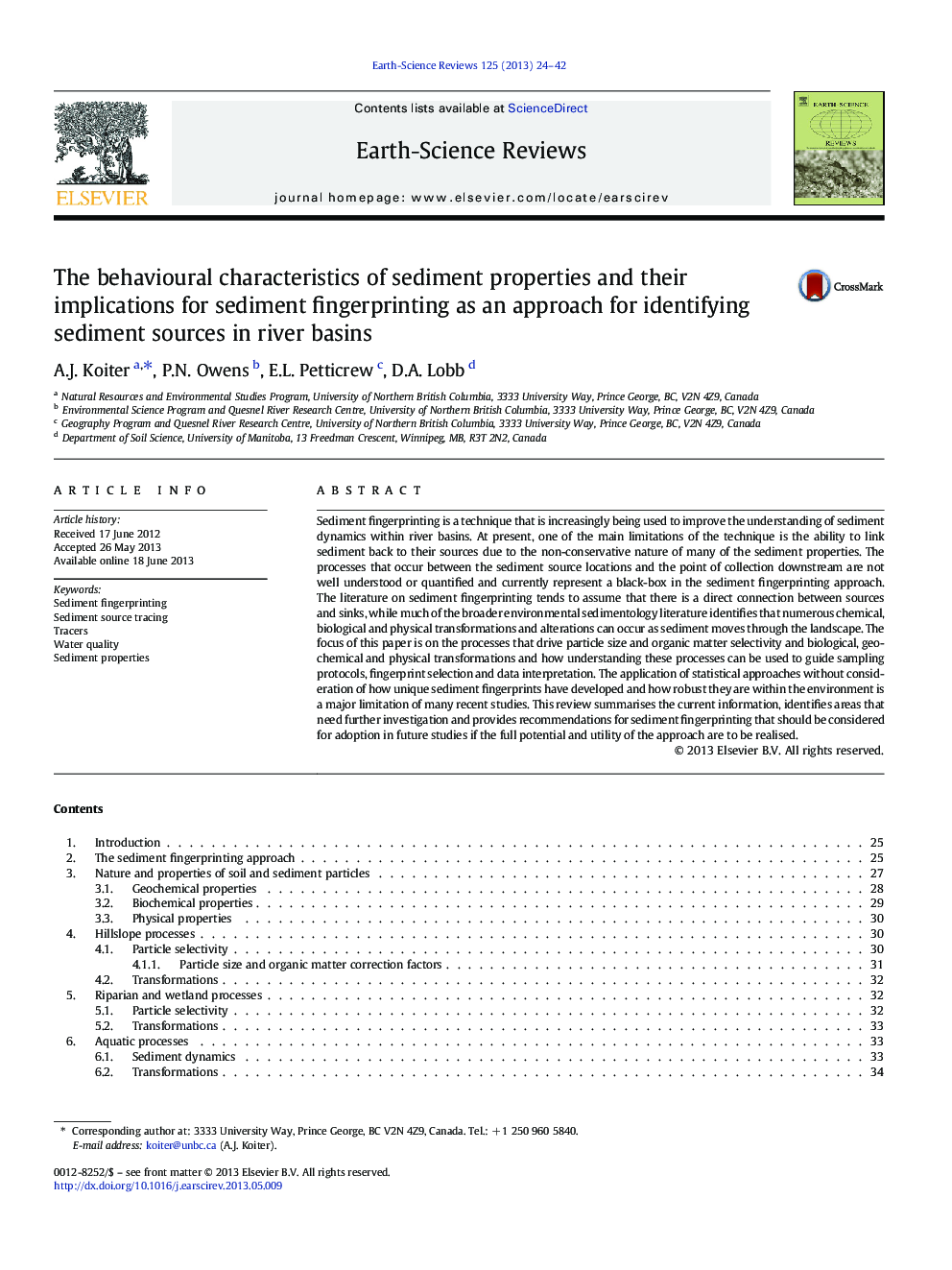| کد مقاله | کد نشریه | سال انتشار | مقاله انگلیسی | نسخه تمام متن |
|---|---|---|---|---|
| 6443167 | 1639977 | 2013 | 19 صفحه PDF | دانلود رایگان |
عنوان انگلیسی مقاله ISI
The behavioural characteristics of sediment properties and their implications for sediment fingerprinting as an approach for identifying sediment sources in river basins
ترجمه فارسی عنوان
ویژگی های رفتاری خواص رسوبی و پیامدهای آن برای دستیابی به اثر انگشت رسوبی به عنوان رویکردی برای شناسایی منابع رسوبی در حوضه های رودخانه
دانلود مقاله + سفارش ترجمه
دانلود مقاله ISI انگلیسی
رایگان برای ایرانیان
کلمات کلیدی
اثر انگشت رسوب، ردگیری منبع رسوب، ردیاب ها، کیفیت آب، خواص رسوب،
ترجمه چکیده
اثر انگشت رسوب یک روش است که به طور فزاینده ای برای بهبود درک پویایی رسوبات در حوضه های رودخانه استفاده می شود. در حال حاضر یکی از محدودیت های اصلی این روش، توانایی اتصال رسوب به منابع خود به دلیل طبیعت غیر محافظه کار بسیاری از خواص رسوب است. فرایندهایی که بین محل منبع منبع رسوب و نقطه جمع آوری در پایین جریان اتفاق می افتد، به خوبی درک یا اندازه گیری نمی شوند و در حال حاضر یک جعبه سیاه در رویکرد اثر انگشت رسوبی را نشان می دهند. ادبیات مربوط به اثر انگشت رسوب به این نتیجه رسیده است که ارتباط مستقیم بین منابع و غرق وجود دارد، در حالی که بسیاری از ادوات وسیع ادوات زیست محیطی نشان می دهد که تحولات شیمیایی، بیولوژیکی و فیزیکی و تغییرات می توانند به دلیل رسوب حرکت می کنند از طریق چشم انداز. تمرکز این مقاله بر روی فرایندهای است که اندازه ذرات و مواد انتخابی ماده آلی و تحولات بیولوژیکی، ژئوشیمیایی و فیزیکی را در بر می گیرد و چگونگی درک این فرآیندها را می توان برای هدایت پروتکل های نمونه برداری، انتخاب اثر انگشت و تفسیر داده ها مورد استفاده قرار داد. استفاده از رویکردهای آماری بدون در نظر گرفتن اثر انگشت منحصر به فرد رسوب و توسعه آن در محدوده محیطی محدودیت اصلی بسیاری از مطالعات اخیر است. این بررسی اطلاعات فعلی را خلاصه می کند، مناطقی را شناسایی می کند که نیاز به تحقیق بیشتر دارند و توصیه هایی را برای اثر انگشت رسوب ارائه می دهد که باید در آینده در مورد مطالعات آینده در نظر گرفته شود.
موضوعات مرتبط
مهندسی و علوم پایه
علوم زمین و سیارات
زمین شناسی
چکیده انگلیسی
Sediment fingerprinting is a technique that is increasingly being used to improve the understanding of sediment dynamics within river basins. At present, one of the main limitations of the technique is the ability to link sediment back to their sources due to the non-conservative nature of many of the sediment properties. The processes that occur between the sediment source locations and the point of collection downstream are not well understood or quantified and currently represent a black-box in the sediment fingerprinting approach. The literature on sediment fingerprinting tends to assume that there is a direct connection between sources and sinks, while much of the broader environmental sedimentology literature identifies that numerous chemical, biological and physical transformations and alterations can occur as sediment moves through the landscape. The focus of this paper is on the processes that drive particle size and organic matter selectivity and biological, geochemical and physical transformations and how understanding these processes can be used to guide sampling protocols, fingerprint selection and data interpretation. The application of statistical approaches without consideration of how unique sediment fingerprints have developed and how robust they are within the environment is a major limitation of many recent studies. This review summarises the current information, identifies areas that need further investigation and provides recommendations for sediment fingerprinting that should be considered for adoption in future studies if the full potential and utility of the approach are to be realised.
ناشر
Database: Elsevier - ScienceDirect (ساینس دایرکت)
Journal: Earth-Science Reviews - Volume 125, October 2013, Pages 24-42
Journal: Earth-Science Reviews - Volume 125, October 2013, Pages 24-42
نویسندگان
A.J. Koiter, P.N. Owens, E.L. Petticrew, D.A. Lobb,
